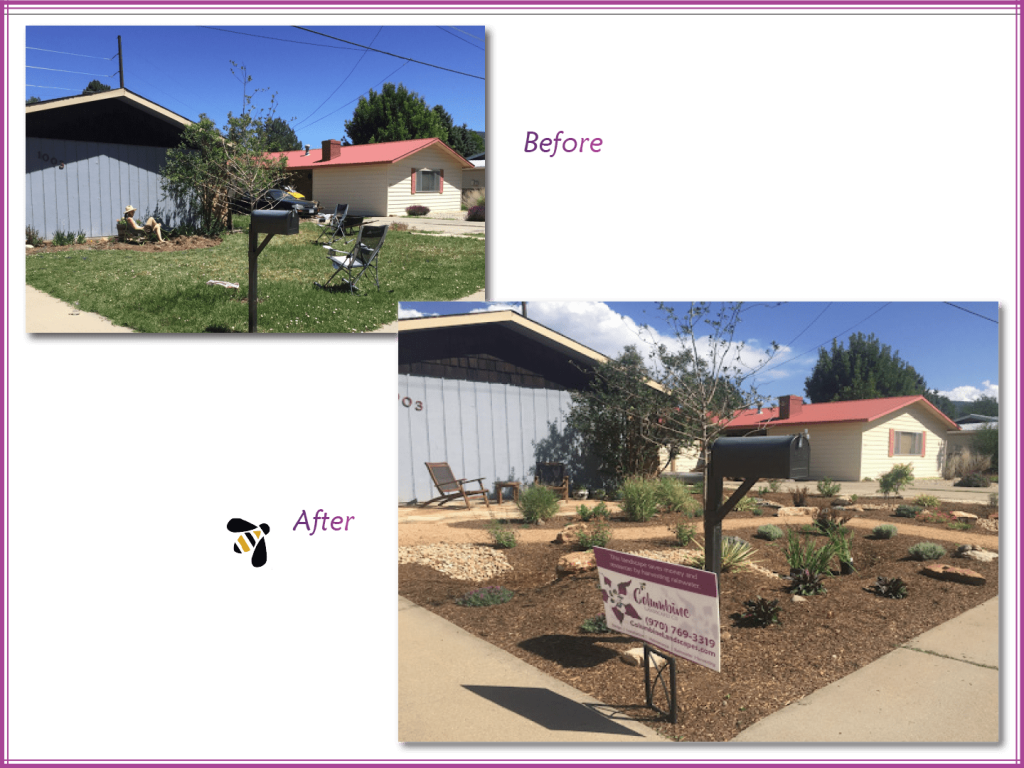01 Sep Lasagna Lawn Removal: How to Passively Get Rid of Lawn Over the Winter
As you may or may not know, there is quite the movement toward removing lawns underway, and we are proud to play a part in this revolution. In 2020 alone, we have removed 7800 square feet of lawn so far, and replaced it with water-wise landscapes (aka XERIscapes, not zeroscapes).
There are many reasons to consider replacing a lawn with flowers and shrubs. Perhaps the most readily acknowledged are decreasing the energy and inputs required to keep a traditional bluegrass lawn looking good in our climate. Money can be saved in terms of a reduced water bill and air pollution resulting from running a lawn mower can also be avoided. Imagine the freedom of not owning a lawn mower; I know there’s a lot of ways I’d prefer to use that space in my garage.
Then there’s the reasons to replace a lawn that are only more recently coming to the fore in the minds and hearts of the American yard owner. Douglas Tallamy has done a bang-up job of educating gardeners and homeowners as to the far-reaching benefits of creating healthy, biodiverse, mini-ecosystems in our landscapes in his landmark book Bringing Nature Home. (If you haven’t read it, I highly recommend it!)
Tallamy’s premise is that we can have more impact than most of us realize, on nurturing local, regional, and even national ecosystems by planting a diversity of native plants in our landscapes. The habitat nature depends upon has been dramatically fragmented in this country which makes it hard for birds, insects, and all kinds of critters to get what they need in close enough proximity to be feasible for them. The more of us who convert our lawns and other less productive landscaping to habitat, the more we’ve helped to connect up the fragmented habitat and support the species that create thriving ecosystems.
Lawn is a monoculture, meaning a single species of plant. Since lawn is mowed regularly it typically never flowers, but even if allowed to, grass is wind pollinated, so does nothing to support pollinators. And it takes chemicals, in most cases, in the form of “weed and feed” herbicides and fertilizers, to keep it looking up to snuff.
So, this begs the question of how best to eradicate a lawn. By concept, it seems simple, but once you really start to figure pros and cons with the variety of approaches, it quickly becomes much more complicated. Manual removal requires a lot of labor and disposal cost, and you sacrifice the organic matter found in the lawn, it’s roots, and the topsoil. Chemicals kill the lawn, leaving the organic matter, but then there are the chemicals. Plastic covering saves the organic matter, but has proven not to be effective and it’s always better to avoid plastics anyway. So…
Lasagna to the rescue! You might think I’m crazy about now, if you haven’t heard of lasagna gardening. It is a simple approach (also referred to as sheet mulching) that is all natural that retains and even builds your organics and soil health. The only real drawback is the time it takes to passively break down, but now, fall, is the perfect time to make your lasagna so you’ll have nice beds ready to plant in by spring!
There are so many great resources already out there about this method that I am going to provide you with a few links with comments.
This link is great if raised veggie beds is what you are going for. It provides really helpful pictures that others may find useful as well.
This site provides a great step by step. However, I disagree with the addition of bark mulch in step 4. Soil Pep is product that I’d recommend since it’s already partially broken down, and so won’t rob the soil of nitrogen if it were to get mixed in like woody matter would.
This one is also helpful for cross reference. Again, I’d avoid the woodchips.
A couple general notes in summary.
- Lasagna lawn removal is a back saving method of all-natural lawn removal with low costs and minimal inputs, making use of resources most of us have on site. It has varying degrees of effectiveness depending on installation methods, duration, materials used, and climatic factors. In our dry climate I highly recommend planning to water it to keep it moist enough to break down. If you choose to do it in fall, it can be a great use of your leaves and if there’s a good covering of snow all winter you’ll be in good shape; otherwise you’ll need to do some watering.
- If you’re planning on planting xeric native and adapted plants, this may not be the best method since they do best in lean soils. I’d love to think there is a way to add a leaner mix of ingredients to the lasagna such that it will still be effective in smothering the lawn, but not be too rich for our native plants. We will be trialing different methods and hope you will too, and would love for you to share your results with us.
To the glory of the garden! Eva
Eva Montane, certified Landscape Designer & President of Columbine Landscapes Co


Sorry, the comment form is closed at this time.